Homework: Workbook Chapter 30
Preliminaries all
Longer Assignments 1,3
Study & Analysis #1,2,6,10
or
Textbook Chapter 30 Preliminaries 1
Write 16 bars incorporating at least 2 usages of textbook preliminaries 1
Workbook Study & Analysis #1,2,6,10
Advanced Uses of Mixture
In Chapter 23 we defined the alteration of the chordal 3rd from its diatonic state as simple and secondary mixture. We now will extend our use of mixture to other chordal elements.
1. Simple Mixture, Secondary Mixture and Double Mixture.
a. We recall from chapter 23 that "simple mixture" is where we borrow an element from the parallel mode. That is, we use the term "mixture" to indicate the appearance of elements from minor in the context of major or the reverse- elements from major used in minor. This is most often applied to the chordal 3rd. One favorite example we have seen is the "Picardy 3rd" where a cadential I chord in minor contains a +^3 yielding a cadential I in major.
b. We also remember that in Unit 23 we defined "secondary mixture" as an alteration of the 3rd of a triad where such alteration does not occur as a result of normal mixture. That is, we altered the chordal 3rd without using scale degrees from the parallel mode.
c. "Double Mixture" occurs when you apply secondary mixture to a triad achieved through simple mixture

2. Simple Mixture
Note: When we apply our definitions of mixture to non-chordal 3rds, we classify simple mixture as being diatonic chords that contain altered scale degrees that occur naturally in the parallel mode of the given tonic key
a. If we apply simple mixture to chordal tones other than the 3rd, we find the most common chords below.
b. It is interesting to note that the mixture is more dramatic in Major than minor as melodic and harmonic minor already contain +^6 and +^7 which are essentially forms of mixture.
c. Note: Even though -^2 is not part of the parallel mode of Major, H&VL count it in our discussion of mixture. You can think of this as a derivation of the NII6

3. Secondary Mixture
Note: When we apply our definitions of mixture to non-chordal 3rds, we classify secondary mixture as being diatonic chords that contain altered scale degrees that do not occur naturally in the parallel mode of the given tonic key
a. If we apply secondary mixture to chordal tones other than the 3rd, we find the most common chords below.
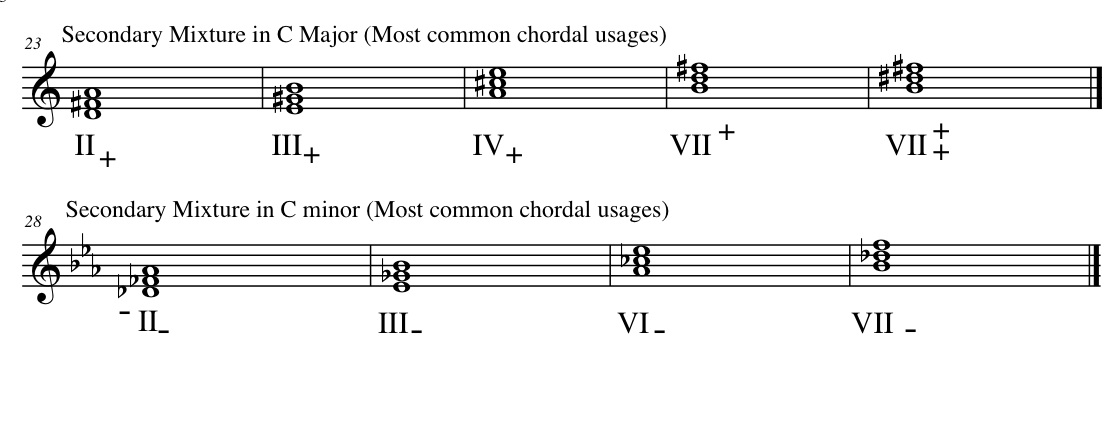
4. Double Mixture
Note: When we apply our definitions of mixture to non-chordal 3rds, we classify double mixture as being simple mixture that contains altered scale degrees that do not occur naturally in the parallel mode of the given tonic key
a. If we apply double mixture to chordal tones other than the 3rd, we find the most common chords below.
b. Note: H&VL defines the -^2 as part of mixture applied to a Major key. The rationale is that it is derived from the Neapolitan function . However, H&VL in example 30-8 shows an Bb minor chord as double mixture in a tonic key of C Major. The parallel minor would contain the Bb and the Db, as previously defined would not be considered an element of double mixture. This example slightly contradicts H&VL's own definition. It is important to understand that there are various opinions regarding the classification of -^2 as an element of mixture. In my opinion, the NII6 is also derived from mixture and, as such, I consider the -^2 not an element that does not exist in the parallel minor.
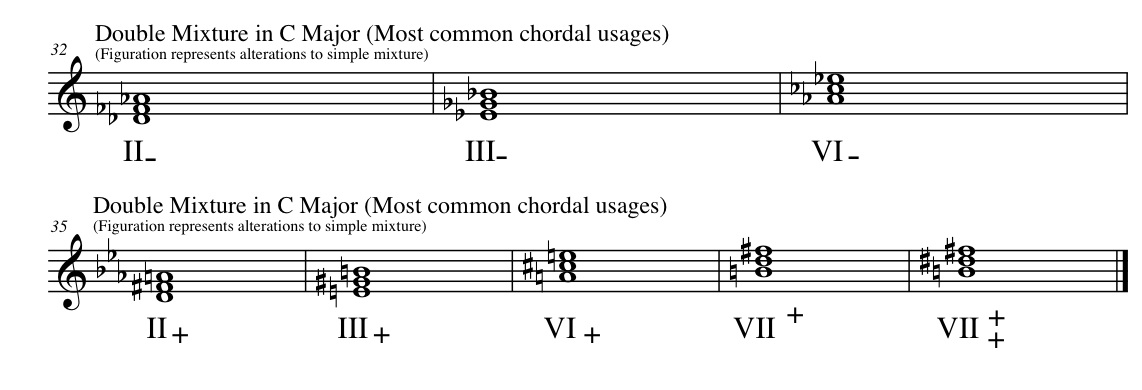
5. Preparing Chromatic Chords
The further a chromatic chord is from its diatonic key area, the more difficult it is to present it within that diatonic conext without it sounding forced and unconvincing. In order to well prepare the ear for an effective use of such chromatic chords we can use a number of techniques.
a. Introduce the altered scale degree in a manner that allows the listener to associate it with a prior statement of the same scale degree used in a simpler more normal context.
b. Precede the chromatic chord with its own applied dominant (or applied Vii) to lead the ear to the chromatic chord.
c. Prepare the chromatic chord with a previous passage in the key of that chromatic chord.
d. Lead to the chromatic chord by stepwise motion in as many voices as possible. To be sure stepwise motion in the soprano and bass to a chromatic chord
will ease the ear into the new tonality.
e. Lead to the chromatic chord by sequence.
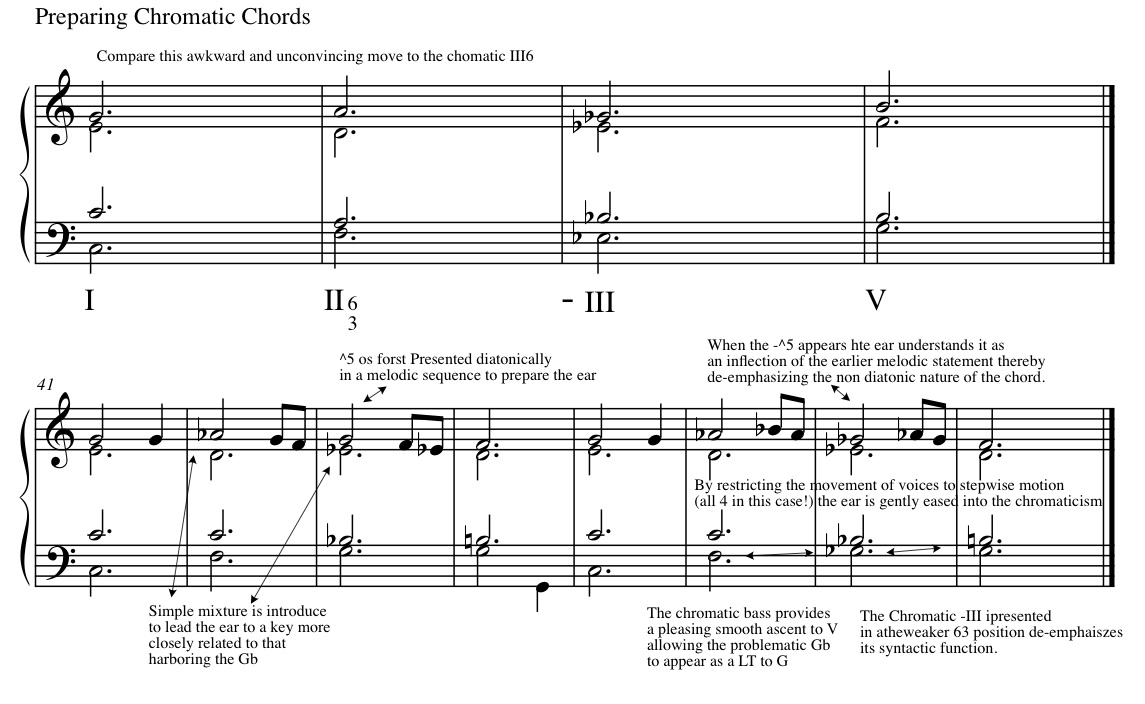
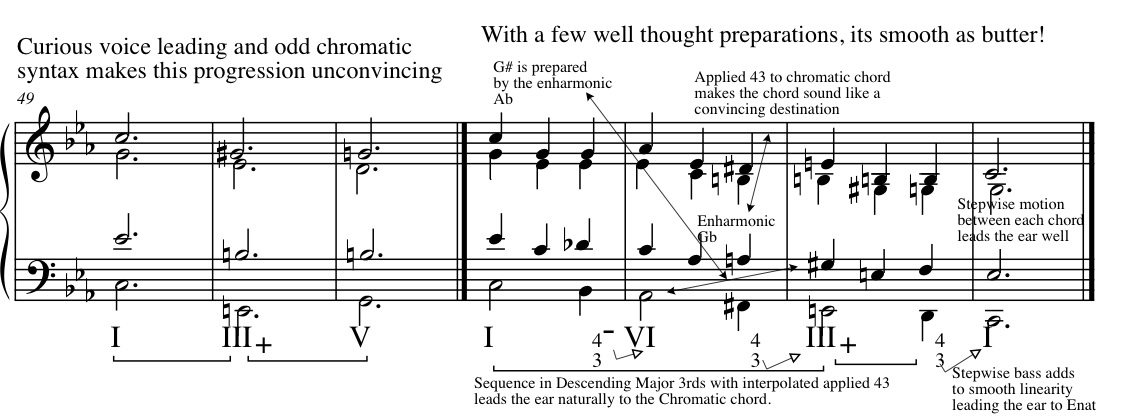
6. Seventh Chords through Mixture
a. As we have seen with II65-3, Viiº7, and GA6, FA6 and AA6 in Major, seventh chords as well as triads can be modified by mixture
Augmented Triads
7. The Augmented 5th as an upper-voice passing tone.
Note: For the most part, augmented triads result from momentary inflections of voice leading or, even when they appear without such inflections, we often think of their appearance as a contraction of a would be inflection. As such the augmented triad expands or represents its major or minor triad and does not function as a self-sufficient harmonic entity.
a. The +^5 often appears as a chromatic passing tone
b. The +^5 often replaces ^5 altogether.
c. The +^5 of an augmented triad very often appears in 63 position
d. The +^5 sometimes decorates a 5-6 progression

8. The augmented 5th as a bass passing tone.
a. Sometimes an augmented chord results from a passing chord htat descends from the root of a minor triad.
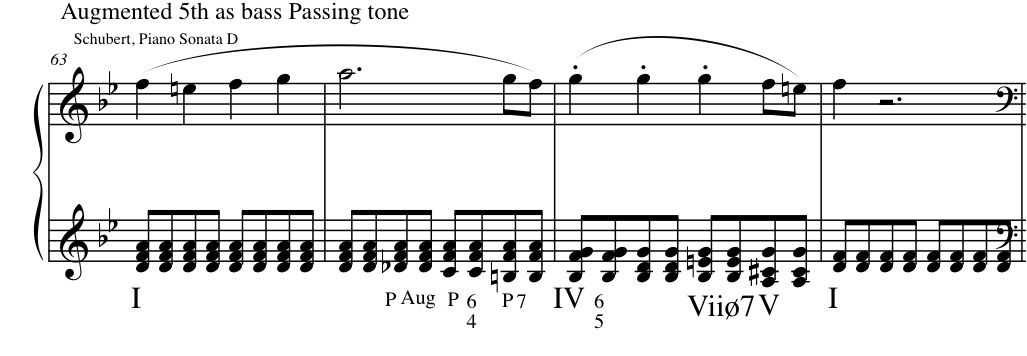
9. Augmented Triads from 5-6-5 Neighboring Progression.
a. Momentary augmented triads may result from neighboring motion that produces a 5-6-5 interval succession
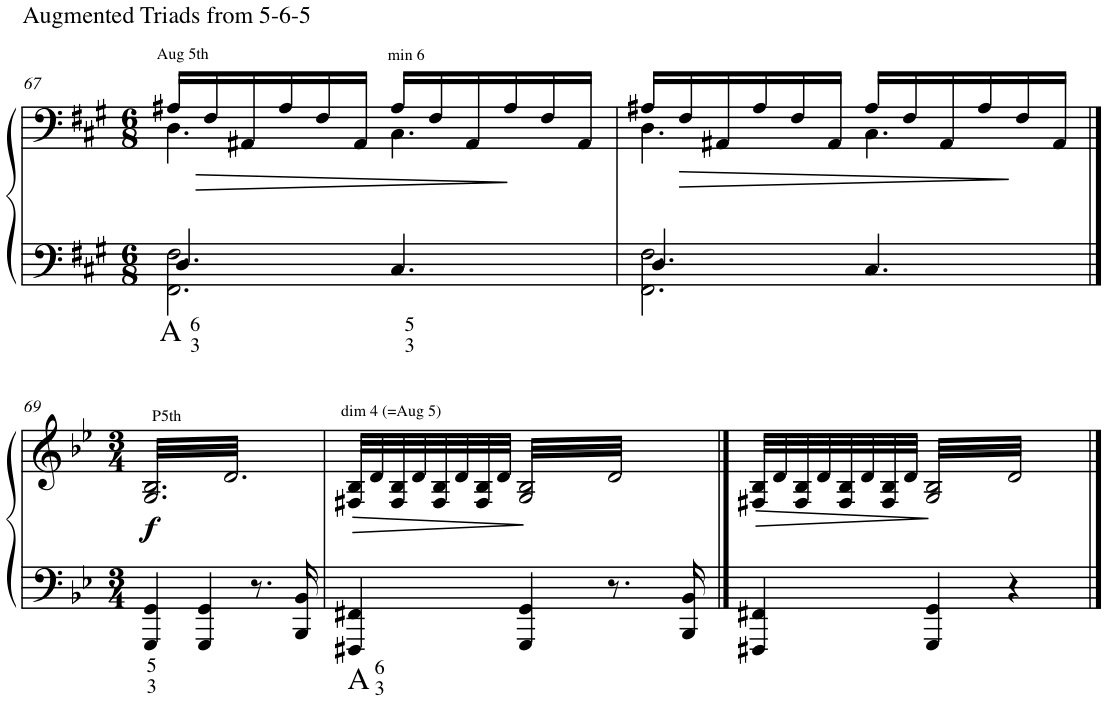
Altered Dominant Seventh Chords
10 & II . V7 with augmented 5th and with diminished 5th.
a. When moving from V7 with an augmented 5th, the +^2 moves as a leading tone chromaticism to ^3
b. When moving from the V7 with a diminished 5th, the -^2 moves as a leading tone chromaticism to ^1
c. 65, 43, and 42 variations are all possible and provide very interesting coloristic textures.
Note: Do not confuse the term dimV7 with a dominant V7 that contains a diminished 5th

Common-Tone Diminished Seventh Chords
12 & 13. A chromatic embellishment of I in Major and its notation.
a. When a diminished 7th chord contains a common tone with the tonic of the preceding chord we call this chord a common tone diminished 7th
b. Although its spelling is demonstrates a dim7th chord with a neighboring function it does not contain a leading tone and therefore functions quite differently from the viiº7 and viiø7
c. The common tone diminished 7th contains ^1 as the chordal 7th and common tone to preceding chord, +^2 as the lower neighbor to ^3, +^4 as the lower nieghbor to ^5, and ^6 as the diatonic upper to ^5
d. Since ^1, the chordal 7th of the common tone diminished 7th, stems from the tonic of the preceding chord we hear that chordal seventh not as our expected dissonance but rather as a consonance. We remember that the term "apparent seventh chord" is used to indicate chords that appear to be 7ths but but in fact are not since the dissonance is not caused by the 7th. As such the common tone diminished 7th is an apparent seventh chord.
e. Since the chordal 7th is the shared ^1, we know the origins of the common-tone diminished seventh to be a 42 chord. As such, to determine a common tone diminished 7th we simply construct a diminished 7th chord in 42 position over the common tone bass.
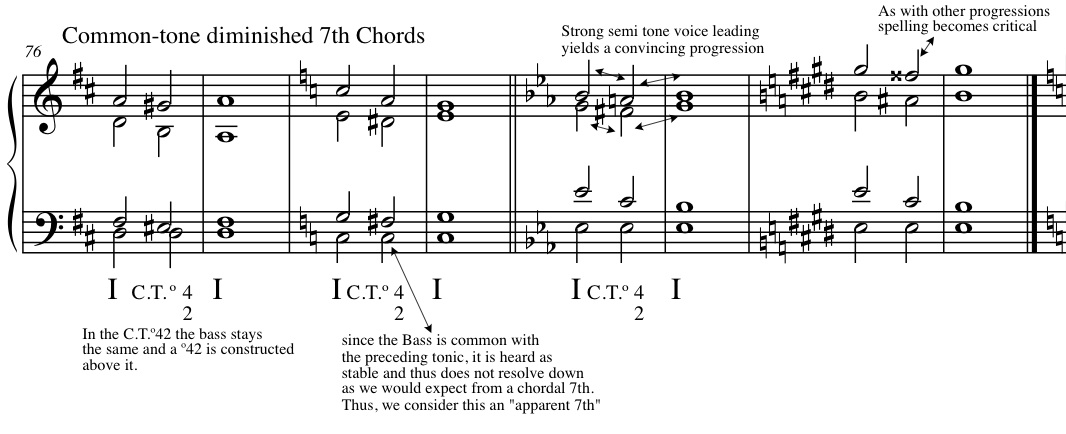
14. Moving to a cadential 64.
a. H&VL makes a point here that when the common tone diminished 7th appears such that the common tone is not in the bass it will sometimes resolve as a regular diminished 7th leading to V via a cad64 and it will sometimes act as an apparent 7th leading back to the tonic (in 64 position) the moving to V. The only difference here is the spelling of the chord.
15. Embellishing a minor triad
a. H&VL points out that Common Tone diminished 7ths dont often embellish a minor triad as the presence of two common tones ^1 and ^3 weakens the contrast. As always, this should not discourage you from using the C.T.º42 as an embellishment of a minor tonic.
b. When embellishing a minor triad with the C.T.º42 it is useful to avoid the common tone ^3 in the soprano in order to keep the ear focused on the moving line. Of course, in moments of repose, one may not want to focus the ear on an active line and utilizing the common tone in the soprano may be desireable.

16. Embellishing V and V7
a. Just as the C.T.º42 leads to and from 1 by stepwise motion while sharing a common tone, so to can the C.T.º42 ead by stepwise motion to V and V7 with ^1 resolving to ^7 by semitone, +^2 resolving to ^2 by semitone, +^4 resolving to ^5 or ^4(as the chordal 7th) by semitone and ^6 resolving to V,
b. When embellishing a minor triad with the C.T.º42 it is useful to avoid the common tone ^3 in the soprano in order to keep the ear focused on the moving line. Of course, in moments of repose, one may not want to focus the ear on an active line and utilizing the common tone in the soprano may be desireable.
c. It is worth nothing that if one enharmonically reinterprets the C.T.º42, it yields a viiº43>V
Note: We remember from theory I that the interval of the diminished 5th wants to resolve inward to a 3rd. We also saw that the augmented 4th would likewise resolve outward to a 6th. With Leading Tone Chromaticism and Semi-Tone voice leading, these two tendancies begin to fade away from our ear as the strength of the additional chromatic voice leading adds gravitational force that counters that tendancy.

17. Common tone augmented 6th chords
a. By inflecting the ^6 of the CTº42 to an -^6, we can enharmonically reinterpret the resultant chord as an Augmented 6 chord sharing a common tone ^1 in the bass.
b. Sometimes composer will allow the bass to leap
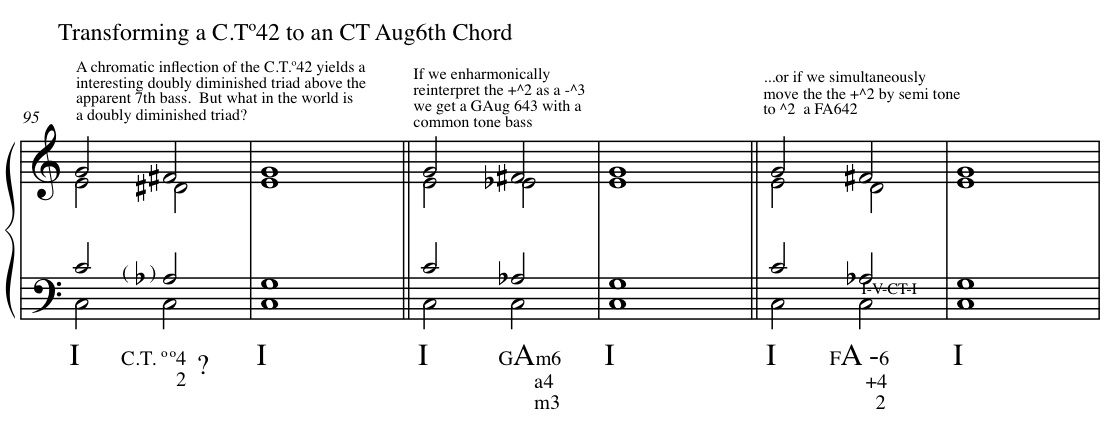
18. Common-tone "dominant sevenths"
a. Much more rare is the Common-tone dominant 7th that yields a dominant type 42 in a unexpected manner
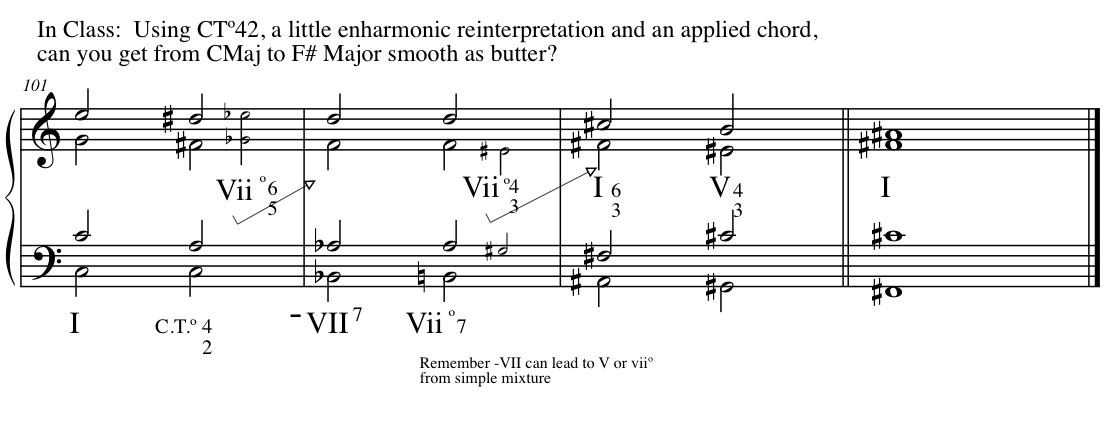
|

